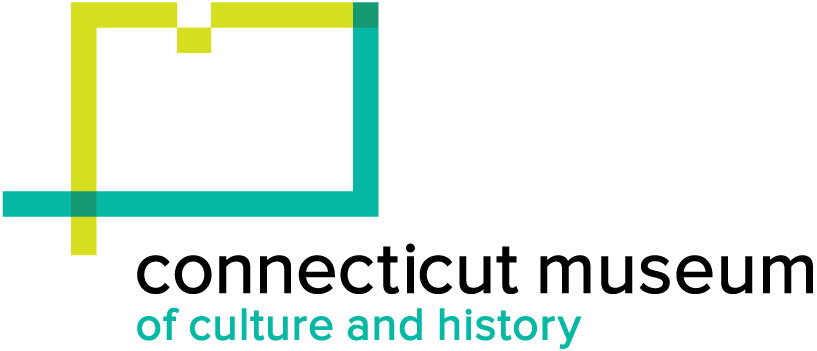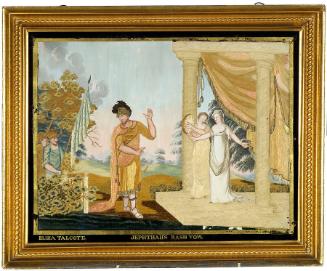Needlework Picture
EmbroidererAttributed to
Frances Ann Brace
(American, 1808 - 1838)
TeacherTaught by
Sarah Pierce
(American, 1767 - 1852)
Date1821-1824
MediumEmbroidery; silk thread and metallic thread on a plain-woven silk ground; glass, wood, gold paint
DimensionsPrimary Dimensions (height x width): 23 3/4 x 22in. (60.3 x 55.9cm)
ClassificationsTextiles
Credit LineGift of Mary W. Edwards
Object number1984.42.1a-c
DescriptionNeedlework picture worked in green, blue-green, dark medium and light blue, tan, cream, pink, and red silk threads with gold metallic thread on a plain-woven cream-colored silk ground using a satin stitch and other stitches. The center of the picture shows a small, shallow beehive on a small hill. Above the beehive are bows and swagged ribbon embroidered with metallic thread. Below the beehive is a floral vine that curves up to meet the ribbon. The picture is behind glass (.c) that is painted black and gold at the edges; each corner has a gold painted star. The gilded wooden frame (.b, original) consists of several shallow moldings including a beaded molding.
Stitches: The primary stitch is satin stitch; it also includes long and short, encroaching satin, flat and outline.
Condition: The backing is replaced. The silk ground is scratched at the top center.
Stitches: The primary stitch is satin stitch; it also includes long and short, encroaching satin, flat and outline.
Condition: The backing is replaced. The silk ground is scratched at the top center.
Label TextBeehives were symbols of industriousness and were particularly popular
in rural settings, where they decorated everything from newspaper
announcements of agricultural interest to roadside tavern signs to parlor
walls. Here gold embroidery threads transform a bee hive made of plaited
straw into a glittering icon, surrounded by an array of flowers and two
tiny bees (at right).
The subtle, restrained elegance of the floral garlands corresponds to
neoclassical sensibilities of the Federal era (ca. 1790–1810) rather than the
bolder styling of the 1820s. By contrast, the flowers around the beehive
are densely massed and worked with thicker, fuzzier threads and coarser
stitching than the outer garlands. These differences suggest that two sets
of hands may have worked this piece at different, perhaps a mother (the
garlands) and her daughter (the beehive).
NotesHistorical Note: The embroiderer Francis Ann Brace attended Miss Pierce's school, in Litchfield, Connecticut from 1821 to 1824. The beehive on the needlework is the symbol of the Litchfield Female Academy, also known as Miss Pierce's School.in rural settings, where they decorated everything from newspaper
announcements of agricultural interest to roadside tavern signs to parlor
walls. Here gold embroidery threads transform a bee hive made of plaited
straw into a glittering icon, surrounded by an array of flowers and two
tiny bees (at right).
The subtle, restrained elegance of the floral garlands corresponds to
neoclassical sensibilities of the Federal era (ca. 1790–1810) rather than the
bolder styling of the 1820s. By contrast, the flowers around the beehive
are densely massed and worked with thicker, fuzzier threads and coarser
stitching than the outer garlands. These differences suggest that two sets
of hands may have worked this piece at different, perhaps a mother (the
garlands) and her daughter (the beehive).
Status
Not on view
















